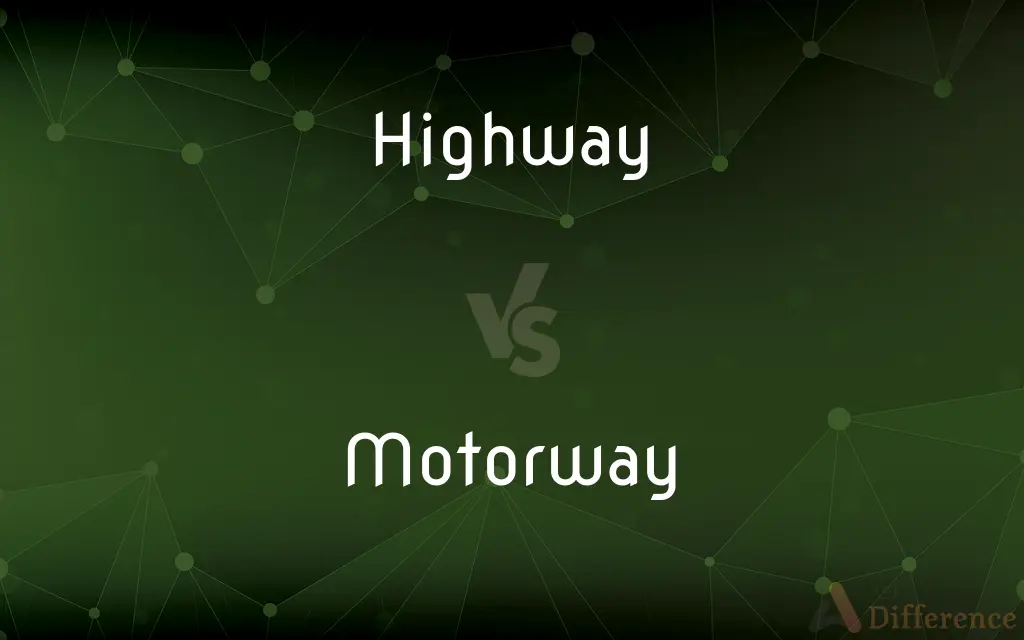Highway vs. Motorway — What's the Difference?
By Tayyaba Rehman — Updated on October 16, 2023
Highways are main roads intended for travel by the public, often connecting towns and cities. Motorways are specific types of highways designed for high-speed traffic with limited or no intersections.

Difference Between Highway and Motorway
Table of Contents
ADVERTISEMENT
Key Differences
Highways are a broad category of roads that are meant for the public to use. They can range from small two-lane roads to expansive multi-lane roads. Motorways, on the other hand, are a subset of highways specifically engineered for high-speed vehicular traffic.
Highways might pass through urban areas, towns, and rural areas. They might have traffic signals, intersections, and may accommodate pedestrians and cyclists. Motorways are typically separate from regular roads and often have controlled access, meaning that vehicles can only enter or exit at designated interchanges.
Maintenance and regulation of highways can vary based on the jurisdiction. They can be managed at local, state, or federal levels. Motorways, given their significance in fast-paced transportation and connectivity, often fall under stricter regulation, often by national or state agencies.
Highways can sometimes have tolls, but many are free to use. Motorways, because of their specialized infrastructure and the costs associated with maintaining them, might more frequently be toll roads. However, this is not a strict rule, and there are many toll-free motorways.
The signage, marking, and even the color codes can be different for highways and motorways. While highways can have varied signs based on the local governing body's choice, motorways often have standardized signs for better understanding and uniformity for high-speed travelers.
ADVERTISEMENT
Comparison Chart
Definition
Main roads for public use.
High-speed roads with limited or no intersections.
Access
Can be open, with intersections and signals.
Controlled access via ramps and interchanges.
Location
Through urban, suburban, and rural areas.
Typically bypasses urban centers.
Traffic Participants
Cars, trucks, pedestrians, cyclists.
Primarily vehicular traffic.
Regulation
Managed at local, state, or federal levels.
Often regulated by state or national agencies.
Compare with Definitions
Highway
Any public road or waterway.
The small town was connected by a single highway.
Motorway
A road specifically designed and built for motor traffic that travels at high speed.
The motorway was clear, allowing us to reach our destination faster.
Highway
A main direct road, especially one connecting major cities or towns.
The highway was congested due to the holiday rush.
Motorway
A long road built for fast moving vehicles, usually with a limited number of places to get on or off.
The motorway network in the country facilitates rapid transport.
Highway
A main road connecting major towns or cities.
The highway stretched endlessly across the vast landscape.
Motorway
A multi-lane road for fast-moving traffic with restrictions on entry and exit.
She joined the motorway at the next ramp.
Highway
A route over which someone or something travels or may travel.
The coastal highway offers scenic views of the ocean.
Motorway
A highway that is designed specifically for high-speed vehicular traffic.
Driving on the motorway requires understanding of specific rules and etiquettes.
Highway
A highway is any public or private road or other public way on land. It is used for major roads, but also includes other public roads and public tracks.
Motorway
A dual-carriageway road designed for fast traffic, with relatively few places for joining or leaving.
Highway
A main road, especially one connecting major towns or cities
The highway to success
A six-lane highway
Motorway
An expressway.
Highway
A main public road, especially one connecting towns and cities.
Motorway
(In Europe, New Zealand and parts of Australia) A highway with grade-separated crossings (rather than level crossings) and designed (and only permitted) for high-speed motor-traffic (in Europe motor vehicles with a higher speed limit than 40 km/h) running in two directions on one separate carriageway each
Highway
(historical) A road that is higher than the surrounding land and has drainage ditches at the sides
Motorway
(Chiefly in the U.S.) A racetrack venue designated especially for the sport of auto racing.
Highway
A main public road, especially a multi-lane, high-speed thoroughfare.
Motorway
A broad highway designed for high-speed traffic
Highway
(figurative) A way; a path that leads to a certain destiny
You're on a highway to greatness.
Motorway
A controlled-access highway where slower vehicles and pedestrians are prohibited.
For safety reasons, bicycles are not allowed on the motorway.
Highway
Any public road for vehicular traffic.
Highway
(computing) bus
Highway
To travel on a highway
Highway
A road or way open to the use of the public, especially a paved main road or thoroughfare between towns; in the latter sense it contrasts with local street; as, on the highways and byways.
Highway
A major road for any form of motor transport
Highway
A route or direction followed by traders or travelers.
Ancient highways were often shaped by trade routes and migration patterns.
Common Curiosities
Why are there tolls on some highways and motorways?
Tolls are used to finance the construction, maintenance, and operation of the roadway infrastructure.
Can you cycle on a motorway?
No, motorways are generally reserved for motorized vehicles and prohibit cyclists for safety reasons.
How does a motorway differ from a highway?
A motorway is a specific type of highway designed for high-speed traffic with limited or no intersections.
Are motorways always multi-lane?
While most motorways are multi-lane to accommodate high-speed traffic, it's not a strict requirement.
Is it mandatory for motorways to have barriers?
Most motorways have barriers or medians for safety, to prevent head-on collisions.
Do highways have speed limits?
Yes, highways generally have speed limits which can vary based on location and local laws.
How are motorways lit at night?
Motorways typically have overhead lighting or reflectors to enhance nighttime visibility.
Can pedestrians walk on highways?
While some highways allow pedestrian access, it's generally unsafe; motorways strictly prohibit pedestrians.
Can you overtake on a highway?
Yes, if it's safe and legal to do so, overtaking is permissible on many highways.
What is a highway?
A highway is a main road intended for travel by the public, often connecting towns and cities.
How are highways regulated?
Highways can be regulated at local, state, or federal levels depending on their jurisdiction.
Why are there rest stops on motorways?
Rest stops provide drivers a place to rest, eat, and refuel, especially during long journeys.
Do all highways lead to cities?
Not necessarily. While many highways connect major cities, they can also lead to towns, villages, or other points of interest.
Are service stations common on motorways?
Yes, service stations offering fuel, food, and amenities are common on major motorways for traveler convenience.
Are all motorways tolled?
No, while many motorways are tolled, there are also many that are toll-free.
Share Your Discovery

Previous Comparison
Anthology vs. Omnibus
Next Comparison
Graduate vs. PostgraduateAuthor Spotlight
Written by
Tayyaba RehmanTayyaba Rehman is a distinguished writer, currently serving as a primary contributor to askdifference.com. As a researcher in semantics and etymology, Tayyaba's passion for the complexity of languages and their distinctions has found a perfect home on the platform. Tayyaba delves into the intricacies of language, distinguishing between commonly confused words and phrases, thereby providing clarity for readers worldwide.
















































